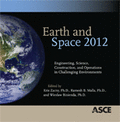Photometric Analysis of the Apollo Landing Sites
Publication: Earth and Space 2012: Engineering, Science, Construction, and Operations in Challenging Environments
Abstract
Disturbed lunar regolith has distinctly different photometric properties than undisturbed regolith. Properties such as composition, grain size and size distribution, grain shapes, glass and Fe0 contents, and structure (fine-scale layering or "fairy-castle" forms) determine how light is reflected from the surface. Photometry can be used to extract this information from regions with different photometric behavior or to compare disturbed and undisturbed areas. Of interest here are regions around the Apollo landers that were disturbed during descent, which we refer to as blast zones. Lunar Reconnaissance Orbiter Camera (LROC) Narrow Angle Camera (NAC) images show that the blast zones are brighter and have distinctly different photometric properties than surrounding regolith, presumably owing to smoothing of the surface and/or removal/redistribution of fine particles. We use phase-ratio images for each landing site to determine the size of the blast zone around each lander and to quantify the differences in reflectance within the blast zones in comparison to nearby undisturbed regolith. Most of the blast zones are elliptical in shape, but some are irregular. The average area of regolith brightening from preliminary measurements for the blast zones is ~115,000 m2, with values ranging from as low as 75,000 m2 for Apollo 15 (~150 m average diameter) to as high as 215,000 m2 (~260 m average diameter) for Apollo 12, which has an enlarged disturbed region extending in the direction of Surveyor Crater. The average normalized reflectance is 0.0480 for the blast zone, 0.0400 for the area under the LM, and 0.0443 for areas outside the blast zone, indicating some process or combination of processes are causing differences in surface properties of the regolith. Whereas experimental work and dynamical modeling indicate that soil grains excavated from beneath the landers would have been transported and deposited many kilometers away, the images provide visible evidence for effects in close proximity to the landers. We are investigating what part of the excavated particle flow regime corresponds to these areas of visible alteration using Hapke modeling. Our working hypothesis is that surface brightening results from scouring and smoothing by exhaust gases, and exposure of fresh regolith material.
Get full access to this article
View all available purchase options and get full access to this chapter.
Information & Authors
Information
Published In
Copyright
© 2012 American Society of Civil Engineers.
History
Published online: Jul 11, 2012
Authors
Metrics & Citations
Metrics
Citations
Download citation
If you have the appropriate software installed, you can download article citation data to the citation manager of your choice. Simply select your manager software from the list below and click Download.
